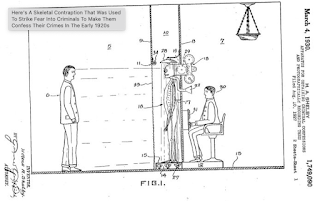With Nancy J. Farrier
 |
| Interrogation Room Wikimedia Commons by Nesnad |
Most of us think of murderers or hardened criminals confessing to the police in an interrogation room. We might picture one of the television shows where they solve the crime and have the confession all within an hour. Can't you picture the interrogation in the room at the left?
Back in the early 1900’s one woman became frustrated with the number of criminals who confessed and then retracted their confession. She wanted there to be a way to keep this from happening, so she designed a contraption to help not only get a confession from the criminal, but to record that confession so there would be no chance of a retraction.
Figure 1 from Patent
In August of 1927, Helene Adelaide Shelby applied for a patent for her invention—Apparatus for Obtaining Criminal Confessions and Photographically Recording Them. Her patent was approved in March of 1930.
Figure 2 from patent showing skeleton from front.
She wanted her invention to create an illusion that would scare the criminal with seeming supernatural elements. She believed the imagination would then create enough fear that the questioner could more easily obtain the confession, although the interrogator would never be seen by the alleged criminal.
Her apparatus was a standing skeleton that faced the accused. The inquisitor remained unseen in a room behind the skeleton, while the criminal was in a room facing the skeleton. As the questioner began his inquisition, the skeleton’s eyes would light up with red lights that blinked eerily. At the same time the question would appear to come from the skeleton.
Figure 3 from patent showing how the eye camera will work.
The head of the skeleton contained equipment for photographically recording the criminal’s statements and reaction. It recorded both pictures and sound. The questions being asked were also recorded so there would be a complete record.
Shelby believed if a person were guilty, the horrific nature of a talking skeleton with glowing red eyes would make them more likely to break down and admit their guilt. The way the skeleton was placed, and the lighting that was used, would give it a spectral quality. The eyes had lights that would appear to blink making them even scarier.
Figure 4 from patent showing the film/recording strip.
Although Shelby’s invention received a patent, I found no evidence that it was ever put to use. Using something this horrific would have constituted a coerced confession. Some people would have given a confession just from being so frightened.
This invention was very well described in the patent and well thought out, but maybe not so practical. It’s hard to imagine a police station using such an unconventional method to solve crimes.
Have you ever heard of Shelby's invention? What do you think would happen if a person would faced with such an apparition? Do you think it should have been put to use? I'd love to hear your thoughts on this unique invention.
Nancy J Farrier is an award-winning author who lives in Southern Arizona in the Sonoran Desert. She loves the Southwest with its interesting historical past. When Nancy isn’t writing, she loves to read, do needlecraft, play with her cats, and spend time with her family. You can read more about Nancy and her books on her website: nancyjfarrier.com.






Thank you for your post today! I have no idea how you stumbled upon this interesting invention, but it's quite an idea! I can understand the frustration of law enforcement when people are so prone to lying. But now more than ever, the legal system is required to avoid any appearance of manipulation.
ReplyDeleteThank you, Connie. My daughter saw an article about this invention. It was so unique, I jus thad to share.
DeleteWow! I've never heard of this. Very intriguing and extra interesting that a woman invented it. I think it could easily created false confessions.
ReplyDeleteLinda, I agree. I might have been terrified and confessed to whatever. lol
DeleteWell, that was certainly creative! Thanks for sharing such a unique discovery!
ReplyDelete